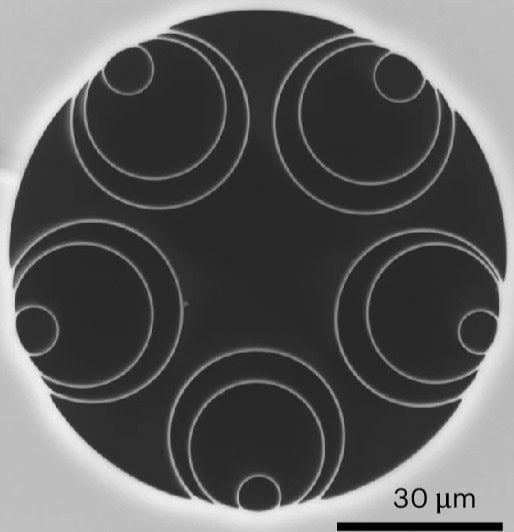Science
Breakthrough in Optical Fibres Cuts Signal Loss, Boosts Speed

Researchers at the University of Southampton have developed a new type of optical fibre that significantly improves light transmission efficiency, breaking a performance barrier that has remained stagnant for nearly 40 years. This innovative hollow-core fibre reportedly exhibits a 35% reduction in signal attenuation and facilitates data transmission at speeds up to 45% faster than conventional glass fibres.
In a study published in Nature Photonics, the team led by physicist Francesco Poletti explains that traditional optical fibres, which consist of a glass core surrounded by a cladding of slightly different glass, suffer from inherent signal loss. Even the best fibres experience attenuation of approximately 0.14 decibels per kilometre, necessitating frequent amplification of signals along the transmission path.
The Southampton team addressed this issue by replacing the glass core with air, which is inherently more transparent. This change reduces light scattering, thereby enhancing transmission speeds. However, the lower refractive index of air prevents the use of total internal reflection, a common method for guiding light in traditional fibres. Instead, the researchers employed a mechanism known as anti-resonance.
The construction of the new fibre involves layering ultra-thin glass membranes to form a hollow channel. This design mirrors the optical behavior of a soap bubble, where specific wavelengths are reflected while others pass through. According to Poletti, this innovative approach keeps light trapped within the fibre’s centre, ensuring efficient transmission.
To validate their design, the researchers conducted rigorous testing on a complete spool of fibre, comparing transmission results at varying lengths. The findings indicated that the hollow-core fibres reduced attenuation to just 0.091 decibels per kilometre. This significant reduction implies that fewer amplifiers would be necessary for long-distance cables, resulting in lower operational costs and energy consumption.
“There’s big potential for greener telecommunications when using our fibres,” says Poletti, highlighting the environmental benefits of reduced energy use in telecommunications. Moreover, at the 0.14 dB/km attenuation level, the new fibres support a bandwidth of 54 THz, compared to just 10 THz for standard fibres. Even at the lower attenuation of 0.1 dB/km, the bandwidth remains impressive at 18 THz.
The enhancement in speed is particularly noteworthy; because light travels faster in air than in glass, data could be transmitted over the same distance at speeds up to 45% faster. Poletti remarks, “It’s almost the same speed light takes when we look at a distant star.” This decreased latency could have a profound impact on real-time applications, including online gaming and remote surgical procedures.
In addition to laboratory tests, Microsoft has begun integrating these hollow-core fibres into its network infrastructure, conducting trials with live traffic. This collaboration demonstrates that the new design is compatible with existing telecommunications equipment, paving the way for gradual implementation.
Looking to the future, Poletti envisions that these fibres could eventually replace current undersea cables, marking a significant evolution in optical communication technology. Despite the excitement surrounding this breakthrough, challenges remain. While creating short, flawless fibre samples is achievable, scaling production to manufacture thousands of kilometres at a low cost presents a formidable obstacle.
The Southampton team is now focused on refining their design and advancing towards large-scale manufacturing. There is optimism that further enhancements could reduce losses even more and adapt the anti-resonant design for specific frequency bands, thereby integrating with new, more efficient amplifiers.
Experts in the field also recognize the significance of this advancement. John Ballato, a researcher at Clemson University, notes, “The work builds on decades of effort to understand and perfect hollow-core fibres.” Although similar fibres have been utilized for short-distance communications, Ballato believes this new development will broaden their application to long-haul networks, potentially transforming the landscape of optical communications.
-

 Entertainment2 months ago
Entertainment2 months agoAnn Ming Reflects on ITV’s ‘I Fought the Law’ Drama
-

 Entertainment3 months ago
Entertainment3 months agoKate Garraway Sells £2 Million Home Amid Financial Struggles
-

 Health2 months ago
Health2 months agoKatie Price Faces New Health Concerns After Cancer Symptoms Resurface
-

 Entertainment2 months ago
Entertainment2 months agoCoronation Street’s Carl Webster Faces Trouble with New Affairs
-

 Entertainment2 months ago
Entertainment2 months agoWhere is Tinder Swindler Simon Leviev? Latest Updates Revealed
-

 Entertainment3 months ago
Entertainment3 months agoKim Cattrall Posts Cryptic Message After HBO’s Sequel Cancellation
-

 Science3 weeks ago
Science3 weeks agoBrian Cox Addresses Claims of Alien Probe in 3I/ATLAS Discovery
-

 Entertainment2 months ago
Entertainment2 months agoOlivia Attwood Opens Up About Fallout with Former Best Friend
-

 Entertainment3 months ago
Entertainment3 months agoMarkiplier Addresses AI Controversy During Livestream Response
-

 Entertainment3 months ago
Entertainment3 months agoMasterChef Faces Turmoil as Tom Kerridge Withdraws from Hosting Role
-

 Entertainment4 months ago
Entertainment4 months agoSpeculation Surrounds Home and Away as Cast Departures Mount
-

 World2 months ago
World2 months agoCole Palmer’s Mysterious Message to Kobbie Mainoo Sparks Speculation













